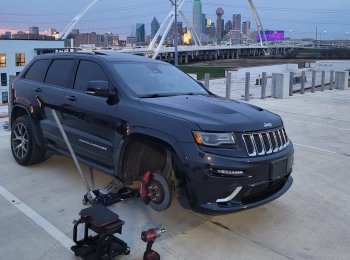The most common signs of a bad alternator are dim or flickering headlights, a weak or dead battery, dashboard warning lights, unusual engine noises, and electrical accessories that work poorly. These problems happen when the alternator cannot produce enough power to keep the battery charged and your car’s electrical systems running correctly. Recognizing these signs early can help you avoid a sudden breakdown. Paying attention to small changes such as weaker lights or slow power windows can save you from costly repairs and unsafe roadside situations. My favorite early warning to watch is dimming lights because it is easy to spot without any tools.
In this article you will learn how to identify the symptoms of a failing alternator, understand why they happen, confirm the problem, and take the right steps before your car stops running completely.
Table of Contents
What the Alternator Does in Your Car
Before diving into the warning signs, it’s helpful to know what an alternator actually does. Your car’s alternator is an electrical generator driven by the engine. Its main jobs include:
- Charging the battery while you drive so it stays ready for the next start.
- Powering electrical systems such as lights, radio, air conditioning, and dashboard displays.
- Maintaining a steady voltage level to protect sensitive electronics from power surges or drops.
If the alternator fails, your car will eventually rely only on the battery for power. Since batteries have limited capacity, this can quickly lead to a total power loss.
1. Dimming or Flickering Lights
One of the first and most noticeable signs of a bad alternator is dimming headlights or dashboard lights. You may notice this happening:
- At night, when headlights appear weaker than usual.
- When you turn on multiple accessories like the radio, wipers, and air conditioning at the same time.
- When lights flicker or change brightness as engine speed changes.
Why it happens: A failing alternator struggles to provide consistent power, especially under heavy load. This causes voltage drops that make lights dim or flicker.
What to do: If you notice this repeatedly, get your charging system tested before it fails completely.
2. Weak or Dead Battery
It’s common for people to think a dead battery means they simply need a replacement. However, if the battery keeps dying even after being replaced or charged, the alternator could be the real problem.
Why it happens: When the alternator can’t recharge the battery, the battery alone powers the vehicle until it’s drained.
What to do: Test the alternator output along with the battery to determine which one is failing. Many auto parts stores offer free testing.
3. Warning Light on the Dashboard
Modern vehicles have a charging system warning light, often shaped like a battery or marked “ALT” or “GEN.” If this light comes on:
- It may glow faintly at first, then get brighter over time.
- It might appear when using high electrical loads like the heater or headlights.
Why it happens: The onboard computer detects abnormal voltage, triggering the light.
What to do: Treat this as an early alert. Continuing to drive may cause your vehicle to stop unexpectedly.
4. Strange Noises from the Engine
A failing alternator may produce unusual sounds, such as:
- Grinding or whining from worn bearings.
- High-pitched squealing from a slipping belt.
Why it happens: The alternator has moving parts like bearings and a pulley. Wear or misalignment can create noise that gets worse with engine speed.
What to do: Don’t ignore new or worsening engine noises – addressing them early can prevent costly damage.
5. Electrical Accessories Working Poorly
If your power windows move slowly, your heated seats take longer to warm up, or your radio cuts out unexpectedly, it could be a sign of an alternator problem.
Why it happens: A weak alternator can’t provide enough power for all systems, so accessories work inconsistently.
What to do: Keep track of when these issues happen – intermittent power loss often points to a failing alternator.
6. Burning Smell or Hot Wires
Sometimes alternator trouble comes with a noticeable odor:
- Smell of burning rubber from a slipping drive belt.
- Electrical smell from overheating wires or components.
Why it happens: A strained alternator generates excess heat, which can damage insulation or wiring.
What to do: Stop driving immediately if you smell burning – continuing could cause fire hazards.
7. Engine Stalling or Difficulty Starting
If your alternator fails completely, your engine may:
- Stall while driving because the ignition system loses power.
- Crank slowly or not at all when starting.
Why it happens: The alternator is no longer supplying enough voltage for the ignition and fuel systems.
What to do: This is an urgent repair situation. Call for roadside assistance rather than risk being stranded in unsafe conditions.
How to Confirm an Alternator Problem
If you suspect alternator trouble, here are steps you can take:
- Check battery voltage with a multimeter. With the engine running, voltage should be around 13.8–14.4 volts.
- Listen for noise changes as electrical load increases – bad alternators often get louder under strain.
- Look for belt issues like cracks, fraying, or looseness.
- Visit a mechanic or auto parts store for a charging system test.
Risks of Ignoring the Signs
Driving with a failing alternator can lead to:
- Complete vehicle shutdown in traffic or on the highway.
- Loss of power steering and braking assist in some vehicles.
- Damage to other electrical components due to unstable voltage.
- Higher repair costs from towing and emergency service.
Addressing the issue early can save hundreds of dollars and keep you safe.
Preventing Alternator Problems
While alternators can fail from age and wear, you can extend their life by:
- Keeping belts tight and in good condition to reduce strain.
- Avoiding overloading the electrical system with too many aftermarket accessories.
- Having the charging system checked during regular maintenance to catch issues before they grow.
When to Repair vs. Replace
Some alternator problems, like a loose belt or minor wiring issue, can be repaired cheaply. However, if the alternator itself is worn out, replacement is usually the best option. Modern alternators are often sealed units, making full rebuilds less practical.
Tip: Always choose a quality replacement unit, as low-grade alternators can fail early and cause repeated problems.
Final Thoughts
Learning to recognize the signs of a bad alternator is one of the simplest ways to protect your car from sudden breakdowns. Whether it’s flickering lights, unusual smells, or slow electrical accessories, these symptoms are your car’s way of telling you something’s wrong. By catching them early, you can avoid expensive repairs, keep your vehicle running reliably, and drive with confidence.
If you ever feel uncertain about your alternator’s condition, have it tested right away. A quick check today could save you from being stranded tomorrow.
FAQs
How long does an alternator last?
Alternators usually last for about 5 to 8 years, which is roughly 100,000 to 150,000 miles. How long it lasts depends on your driving habits and how much you use your car’s electrical devices. If yours is getting old, you should monitor it during regular checkups.
Can I drive with a bad alternator?
No, not for long. If the alternator is bad, your car is running only on battery power. That power will run out quickly, often within 20 to 30 minutes. You should stop driving as soon as possible and call for help. When you need urgent service, NeedMechanic allows you to post a repair request and find a mechanic fast.
What's the cost to replace an alternator?
The total cost can be anywhere from $400 to $1,000, sometimes more for luxury cars. This includes the part itself (which can cost $150 to $500) and the labor. You can use NeedMechanic to browse local shop listings, compare prices, and contact mechanics near you directly for quotes.
Do alternators fail suddenly or gradually?
They usually fail gradually. You will often see the warning signs first, like dimming lights or a battery light flickering. However, if the drive belt breaks or a key component shorts out, it can fail suddenly, causing your car to stop right away.
Is replacing an alternator a DIY job?
For most people, no. While experienced home mechanics can do it, it’s a complicated job that involves disconnecting the battery, removing belts, and handling heavy parts in a tight engine space. It’s best to have a certified technician do it to avoid injury or damage. You can easily find a certified professional through NeedMechanic.
What damages an alternator?
Common things that shorten an alternator’s life are excess heat (from a hot engine compartment), electrical overload (from too many powerful accessories), and physical damage like a bad pulley bearing or a loose, slipping belt.
Why does my battery keep dying even after I charge it?
This is a classic sign of a bad alternator. The alternator’s job is to recharge the battery while you drive. If it fails, the battery runs down and stays dead. If you are having this repeated problem, you need to find a shop for a charging system test. Post your request on NeedMechanic and let the mechanics find you.
Why is there a whining noise coming from my engine?
A whining or grinding noise that gets louder when you speed up is often a sign that the bearings inside the alternator are worn out. A high-pitched squeal is usually a loose or worn belt. Either way, get it checked right away by a professional.
Why does my car struggle to start sometimes, but not always?
This can happen when the alternator is failing intermittently. It might charge the battery enough to start the car sometimes, but not enough other times. This inconsistent charging is a serious warning sign. Use the mechanic listings on NeedMechanic to find a nearby repair specialist quickly.
Should I buy a new or a remanufactured alternator?
A new one is usually best, as it has all-new parts and a longer life. Remanufactured means it uses some old parts that were cleaned and rebuilt. While cheaper, a quality, new replacement is often a better investment for long-term reliability.










Leave a Reply